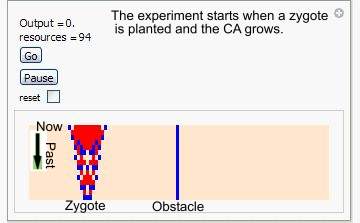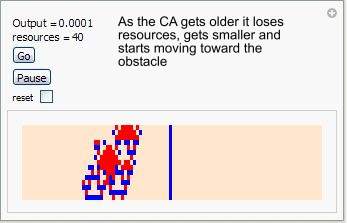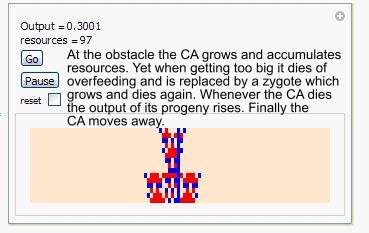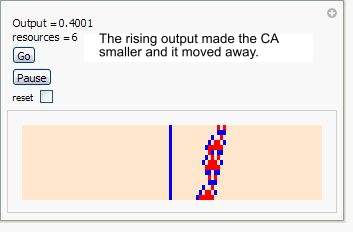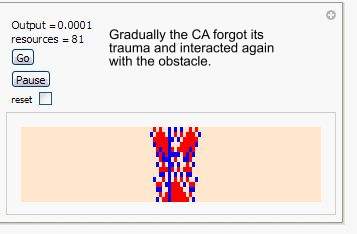 |
CA Conditioning
Conditioning
is a vital mechanism by which organisms interpret the environment. Psychology
regards it as a process of behavior modification by which
a subject comes to associate a desired behavior with a previously unrelated
stimulus.
http://www.answers.com/Conditioning?cat=health&gwp=11&method=3&ver=2.3.0.609
Conditioning was discovered by Ivan
Petrovich Pavlov, who studied salivation physiology in dogs. Salivation
is induced whenever the dog smells or sniffs food. In an experiment
Pavlov rang a bell when feeding the dogs with meat and measured the amount
of saliva. After two weeks of training he rang the bell without feeding
the dogs, and the animals salivated as if they were sniffing meat.
CA behavior
The
previous experiment showed a CA moving around in a search for resources.
Finally it hit upon an obstacle which provided them. In order to interact
the observer had to raise the input a bit whereupon the CA stopped moving
and remained there. The CA aim was to maximize resources.
CA mood or satisfaction was manifested by its behavior. When hungry
it lost weight (shrunk) and moved faster. When interacting with the obstacle
it gained weight and stopped moving. Observing the experiment we might
have concluded that the obstacle triggered CA behavior.
CA
Conditioning
The present experiment demonstrates how a CA is conditioned by the obstacle.
Like in the previous experiment, the CA moves around (input > 0), searches
for resources, and encounters the obstacle. It then accumulates resources,
yet when overweight it dies, and is replaced by a zygote. The same fate
awaits the newly born, and the CA soon dies. However when a zygote is formed,
CA output is raised a bit, and when output > input the CA leaves its
prison. It is small and hungry but free and will not interact with the obstacle.
With time the CA forgets its traumatic experience, (output declines) and
when input > output it is ready to interact with the obstacle and be
conditioned.
Please consider the following:
- When conditioned, the CA remembered its trauma. It learned not to grow
above a certain size. This memory was embodied in the entire CA.
- The obstacle served as a trigger. It shaped the CA memory.
Further reading:
Memory of a complex system
Will
and Imagination
-----------------------------------------------------------------------------------------------------------------
